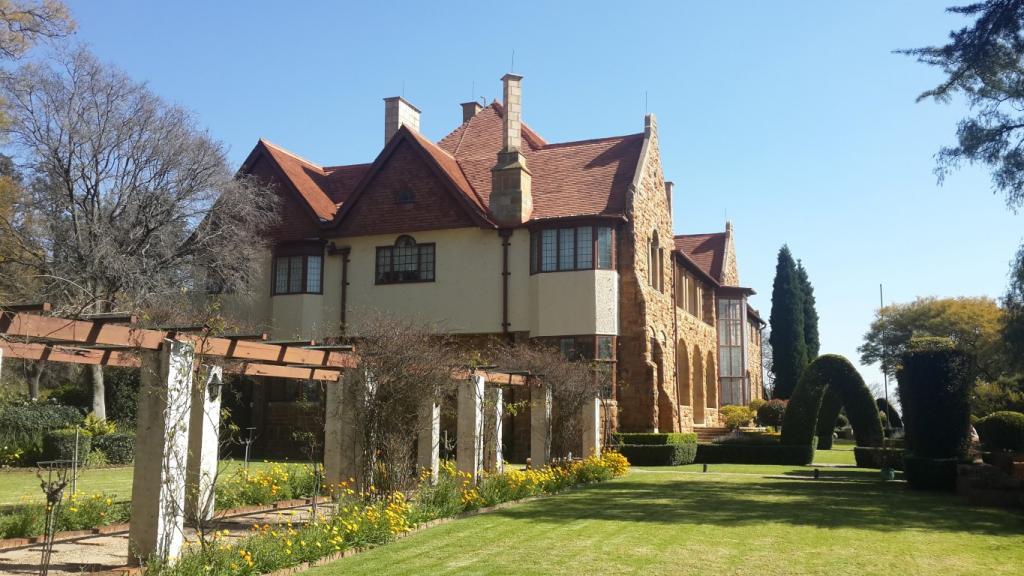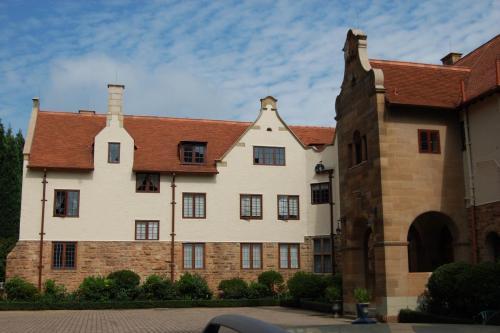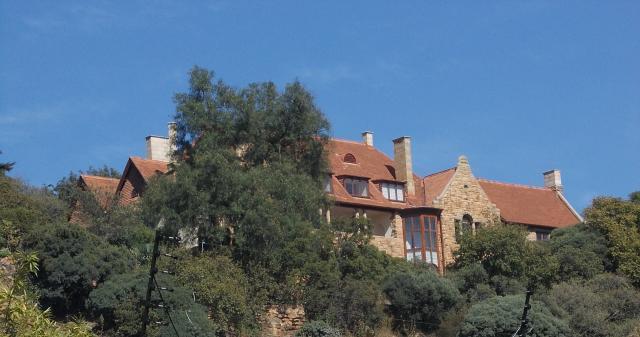
Disclaimer: Any views expressed by individuals and organisations are their own and do not in any way represent the views of The Heritage Portal. If you find any mistakes or historical inaccuracies, please contact the editor.
The following epic case study, written by Albrecht Holm, appeared in a 1996/7 edition of the old Johannesburg Historical Foundation's Journal 'Between the Chains'. It not only highlights the significance of the site but also the skill of a spectrum of professionals needed to achieve the spectacular result.
With Northwards restored to something akin to its original form, the question 'for what purpose?' needs to be addressed. The answer is two-fold. First it must be used. Furthermore, the interested public should have access. In this way one could talk of a living monument rather than a museum" - Neil Viljoen, Johannesburg College of Education (JCE) Trust. What does an architect do with such a brief? Is there still a place for monuments in our present situation? And what is a living monument? Such questions I have asked myself many times and still do so today when I view the golden coloured castle atop the Parktown ridge. The fact that Gencor [now BHP Billiton] was prepared to invest millions in the restoration and upkeep of an old house and to convert it to a 'living monument' at first also struck me as something quite extraordinary. Is this pure romanticism? Or is there a need behind it?
The Need for Upliftment
At the turn of the century Johannesburg was little more than an oversized shanty town, a pioneer's world, a fortune-seeker's paradise with thousands of poor people and a few very rich. There was a dearth of everything refined or cultured and to many a dearth of women, particularly those of breeding. Here lived John Lace, handsome and wealthy enough but unfulfilled and stricken by a feeling of emptiness.
Then she came from the Karoo, Jose Brink, young, wild and beautiful. Her romance with John spanned the distance from Johannesburg to London and back and was attended by grief, seduction, marriage, divorce and re-marriage before they settled down as a married couple.By then they had acquired a new surname and called themselves Dale Lace. She had decided on the change.
They settled in Doornfontein, but soon this was not good enough for them (her). Florence Phillips (later Lady Florence) had explored the ridge just north of Doornfontein on horse-back and discovered the incomparable view to the Magaliesberg range from there. This was to become the sought-after Parktown ridge where Randlords would settle in due course. It was here that John purchased a nine-hectare piece of ground, large enough to accommodate horse stables, a dairy, vegatable garden, cultivated field and an orchard. Jose made sure that he employed the architect of the day, Herbert Baker (later Sir Herbert), to design her home.
For the caretaker's cottage as well as the stables Baker used the Cape-Dutch style of architecture - perhaps to remind Jose of her Cape background. He also used Cape Dutch elements in the design of the main gable. The young couple lived in the caretaker's cottage while the house was being built. For this, Baker's first major work in Johannesburg and his largest house, he applied all his ingenuity. His Arts and Crafts Movement blossomed here and he was able to give it full reign. He introduced Jose to an interior decorator, Mr Clark, so that she was able to imprint her own personality on the decor. This was rather more Victorian than anything else, but it was what she termed "Hollywood Style". Thus the home was not typical Baker throughout. It was a combination of the Arts and Crafts Movement and English Vernacular architecture linked with the culture of the Cape and cosmopolitan Johannesburg. While Jose was no match for Florence Phillips on cultural grounds she was able to trump her with this house.
Pinnacles of perfection seldom last for long and after seven years of a flamboyant lifestyle on the bare ridge, the Dale Lace home, and their fortune, went up in flames. It was said that Herbert Baker's wife woke her husband and, pointing at the flames said, 'there is work for you'. It was however, not to be Baker who did the first restoration of Northwards.
Main Entrance Northwards (The Heritage Portal)
Stately Family Home
The ruins were still smouldering, enter George Albu (later Sir George). He was the sort of man who was less impulsive than the average Randlord and made good use of opportunities that presented themselves. A sober man, an astute businessman, a restorer and the founder of Gencor, he was the leader of a group of mining magnates who did not subscribe to Rhodes's imperialistic ambitions and supported the ZAR instead.
But politcs did not influence his life unduly. Albu was a man who sought value for money and he was able to learn from the mistakes of others. He could learn a great deal from John Dale Lace. He knew not to let his wife's imagination have free reign and was aware of the dangerous combination of a woman with imagination plus the best architect in town. He chose the lesser known Swiss architect, Theophile Schaerer, who could be depended on to do what Albu wanted rather than try to put his own individual stamp on the plans. Albu and his wife, Gertrude, had a large family. He therefore decided to enlarge the original Baker home and make it more suitable to his needs adding a large dining room and a double-storeyed bedroom wing, since eating and sleeping are the most important aspects of family life.
At the same time he appreciated quality and also valued it. He retained all the more important aspects of the Baker design. These included the large ballroom, the spacious entrance halls, lobbies and living rooms as well as the elegance of the lay-out and landscaping. Being a sober man, however, he converted the Dale Lace's merry billiard room into a restful study.
In his Father's Footsteps
Sir George Albu's business, the home and his title were inherited by his son, Sir George junior. Photographs of the time show that George effected little change to the house except that the rooms were less lavishly furnished. He managed the estate and kept a large number of wild animals for the amusement of his children. The house remained in the Albu family's posession until 1954 when it was sold to the South African Broadcasting Corporation (SABC).
In this period of the Albu tenancy some of the negative apsects of preservation without development are evident. The house and estate did not change but their surroundings and circumstances changed dramatically, leaving the home and estate 'out of step'.
Struggle for Physical Survival
The 1960s were marked by unsympathetic change, innovation and development in the spirit of modernism. The new motorway cut through the koppie and the old gate house and gate 'had to be' demolished. It was a time when conservationists often fought a losing battle to save heritage sites for as long as was needed to change the views of decision makers or until they were replaced by those with other views. The reason the SABC acquired Northwards was not to preserve it, but because the rocky ridge was ideal for the erection of a broadcasting tower. The Parktown and Westcliff Heritage Trust [now the Johannesburg Heritage Foundation], led by Mrs Flo Bird, needs to be mentioned here. It was due to their efforts that the building was saved. But it was not yet preserved. It was to go through the mill of being adapted for use as a boarding house and later as an office block, all of which left grave scars. The beautiful stables were demolished during this time. The TPA moved in after Northwards was vacated by the SABC. Finally it became the property of the JCE Trust. Too many consecutive owners and tenants tend to cause havoc in a home. The recent restoration by Gencor was thus a necessity and not just a nice-to-have.
Second Revival
On the grounds that Sir George Albu senior was the original founder of the company General Mining, its successor, Gencor Limited, undertook to negotiate a long-term lease on the property. A multi-million rand restoration was embarked upon with a view to making Northwards a 'living monument'. Restoration is a science encompassing both advanced technology and art. The art lies in having the intuitive powers to select from sometimes opposing research results in order to achieve a balanced whole. The science encompasses not only painstakingly researching the history and structure of the building but also determining what the different role-players wished to express and achieve. The technology lies in the expert combination of old and new materials and methods. For example a geological investigation was necessary to identify replacement sandstone that would be compatible with the original and, over the years, would weather to the same colour as the existing sandstone. To achieve this, slivers of one micron thick were cut from various sandstone samples and their mineralogy was studied under the microscope.
Thus restoration is a team effort between architect, quantity surveyor, engineer, geologist, cultural history researcher, interior decorator, building contractor, sub contractor and artisan. The link in this chain is the client.A restoration brief was prepared by Holm Jordaan Holm. It took into account historical background, personalities and their influence on the building, the environmental impact and last but not least the client's instructions and wishes as well as practical considerations. The recommendations included the following:
Expert technical restoration was to be carried out on the stonework, windows, roof and gutters. It should always be the aim to find long-term solutions to solve the cause of problems rather than cure the symptoms.
In broad outline the building would be restored both inside and out to the condition and level of workmanship that existed in the time of Sir George Albu senior. The main rooms with the Baker stamp had not been altered by Albu. These were to retain their Baker character and be restored accordingly. The drawing room and the main bedroom, which had been designed by Clark, would also be restored to their original condition, as far as possible. The remaining passages and the rooms which were to be used mainly as offices would be decorated, where possible, in the finish and colours used by Sir George Albu junior. Later additions and changes would be demolished and/or restored to the original design.
Site considerations: The approach and entrance to a home are of paramount importance and it was recommended that these should be in accordance with the original plan. It would be necessary to construct a road to the south of the house across the koppie. The original gates were to be re-erected at the entrance. Reconstruction of the original pergola and summer-house were planned. The vegetation and garden design were to be restored to the original, as far as possible.
All services ie. water, sewage, stormwater, electricity, telephone, fire hydrants, heaters etc. were to be restored or replaced by new equipment and services.
As far as possible the original materials were used in the restoration. A carved, marble mantelpiece that was removed from the house in earlier years was carefully removed from its new home and refitted in its original position in the drawing room at Northwards. Restoration of the light fittings was another story! Luck played a part in this aspect. One wonders how much could have been achieved if restoration had been delayed another few years.
Northwards from The Valley Road (The Heritage Portal)
Living Monument
Care and concern for the finer things in life, particularly those unable to care for themselves, can be viewed in the light of man's aspiration to the highest level of civilisation and refinement. These are noble traits. When an individual or organisation follows-up on the care and concern with appropriate action, then a positive and valuable contribution to preservation and culture in general is achieved. It is this kind of action that elevates man and wrenches him from Darwin's scheme of 'survival of the fittest'. Furthermore, if the action is perceived to be both necessary and beneficial and elicits an answering chord of response in public participation and enthusiasm, then a living monument can come into being. So let it be be with Gencor's restoration at Northwards!
Comments will load below. If for any reason none appear click here for some troubleshooting tips. If you would like to post a comment and need instructions click here.


